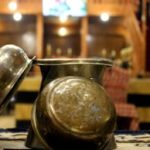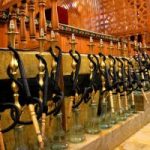Aleppo, SANA- The archaeological Hammam al-Nahhasin (al-Nahhasin public bathhouse) in Aleppo Old City which dates back to the Ayyubid era has restored its splendor and glamour after being rehabilitated after the terrorist war which dragged on for ten years, to restore the rituals of joy to its neighborhoods and the old markets of Aleppo adjacent to it.
The ancient al-Nahhasin bathhouse dates back more than 950 years, according to its owner, Ibrahim Qattan, who told SANA reporter that the one who ordered its construction was Aisha bint Salah al-Din al-Ayyubi.
The visitors of Hammam al-Nahhasin go through small alleys to reach the bathhouse as it is located behind the Great Umayyad Mosque where these alleys intersect with the roads leading to al- Shibani Church and the Farafra neighborhood.
Qattan added that the bathhouse was historically divided into two parts, the first and it is called al-Sitt Hammam (bathhouse), and it was intended for women, and the second was the coppersmith’s bathhouse for men.
Qattan added: “The bathroom has an old and unique architectural style adorned by domes that have small openings for lighting, and you enter it through going down the stairs as it is slightly under the ground in order to keep the heat and provide warmth for the visitors.”
He pointed to the great damage caused to parts of Hammam al-Nahhasin as a result of terrorism in 2012, adding that with the liberation of Aleppo and the return of security and safety to it, work has been done to rehabilitate and restore the bathhouse and equip it in preparation for putting it into service soon and opening its doors to its visitors, as it can accommodate more than 200 people and it used to host social events, including weddings.
The Hammam is divided into three sections: The internal section (often called al-Juwani) contains the warm rooms and the hot rooms. The warm rooms are designated for a short relaxation before taking bath. The hot rooms are designated for a full body wash and steam bath.
The central section (often called al-Wastani) of the Hammam is designated for a massage after the body wash. While the external section (often called al-Barani) is the largest part of the Hammam, and it is characterized with its traditional wooden decorations and marble floor. Here, bathers can take a period of relaxation around the pond.
In turn, Saleh Abu Mohair, who spent years working in the bathhouse, talked about the stages of bathing, where the person who wants to take a shower enters, and is given a piece of cloth called the “mazer” and takes a shower in the central section, then moves to the steam room to come to the role of a worker called “al-Mukayyes” who helps him in the bathroom using a cloth bag which used mainly for bathing at Hammamat al-Souq (market bathhouses). After finishing, he goes to the Barani section for hot drinks.
Mohair added that the bathhouse witnesses joy occasions, including the bath of the groom, who comes with his friends and bathes on the ancient folkloric songs of joy.
Ruaa al-Jazaeri
 Syrian Arab News Agency S A N A
Syrian Arab News Agency S A N A










